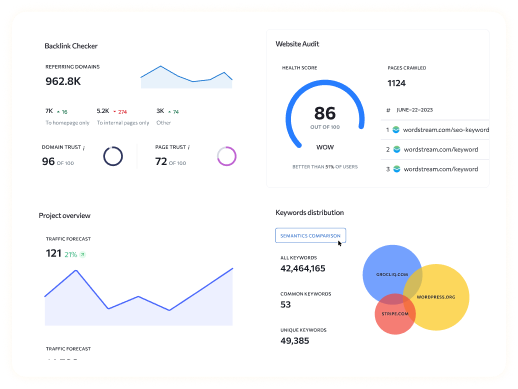Crafting compelling and optimized content is essential for driving organic traffic and engaging your audience. To help you create copy that users love and search engines appreciate, we’ve compiled 19 actionable SEO content writing tips.
1. Understand Your Audience
Before you start writing, research your target audience’s demographics, interests, and pain points. Tailor your content to address their needs and preferences effectively.
2. Conduct Keyword Research
Identify relevant keywords and phrases related to your content using keyword research tools. Target long-tail keywords with moderate search volume and low competition for better visibility.
3. Create Compelling Headlines
Craft attention-grabbing headlines that accurately represent your content and incorporate target keywords. Use power words and emotional triggers to captivate your audience’s interest.
4. Write Quality Content
Focus on producing high-quality, informative, and engaging content that provides value to your audience. Avoid keyword stuffing and prioritize readability and user experience.
5. Optimize Meta Tags
Optimize title tags and meta descriptions with relevant keywords to improve click-through rates (CTR) in search results. Keep titles under 60 characters and meta descriptions under 160 characters for optimal display.
6. Use Subheadings and Bullets
Organize your content with descriptive subheadings and bullet points to improve readability and scanability. Structure your content logically to guide readers through the information seamlessly.
7. Optimize Images
Optimize images by compressing file sizes for faster loading times and adding descriptive alt text with relevant keywords. Use high-quality visuals to enhance the overall user experience.
8. Incorporate Internal Links
Include internal links to relevant pages on your website to improve navigation and distribute link equity. Link to authoritative sources externally to provide additional context and credibility.
9. Prioritize User Intent
Understand user intent behind search queries and align your content with their informational, navigational, or transactional needs. Answer common questions and provide solutions to user problems.
10. Implement Schema Markup
Utilize schema markup to enhance your content’s visibility in search results and provide search engines with additional context about your content. Use structured data to highlight important information, such as reviews, FAQs, and product details.
11. Optimize Page Speed
Ensure fast loading times for your web pages by optimizing images, minifying CSS and JavaScript files, and leveraging browser caching. Use tools like Google PageSpeed Insights to identify and address performance issues.
12. Publish Fresh Content Regularly
Consistently publish new and relevant content to keep your website updated and attract both users and search engines. Refresh existing content periodically to reflect changes in your industry or address emerging trends.
13. Encourage User Engagement
Encourage user engagement by soliciting comments, shares, and reviews on your content. Respond to comments promptly and foster a sense of community around your brand.
14. Leverage Social Media
Share your content across social media platforms to increase its reach and visibility. Encourage social sharing by including social sharing buttons on your website and creating share-worthy content.
15. Monitor Performance Metrics
Track key performance metrics such as traffic, engagement, and conversions to measure the effectiveness of your content. Use analytics tools to identify trends, patterns, and areas for improvement.
16. Optimize for Voice Search
Optimize your content for voice search queries by incorporating natural language and conversational phrases. Answer commonly asked questions concisely and provide clear, informative responses.
17. Conduct A/B Testing
Experiment with different variations of your content, headlines, and CTAs using A/B testing to identify what resonates best with your audience. Use data-driven insights to refine your content strategy and improve performance.
18. Stay Updated on SEO Trends
Stay informed about the latest SEO trends, algorithm updates, and best practices to ensure your content remains relevant and competitive. Follow industry blogs, attend webinars, and participate in online communities to stay ahead of the curve.
19. Continuously Improve
Regularly audit and analyze your content to identify areas for improvement and optimization. Iterate on your content strategy based on performance data and user feedback to drive continuous improvement.
Related Resources
- SEO Content Writing Tips: Get valuable SEO Content Writing Tips on Grocliq’s Glossary page.
- Top Skills of an SEO Manager: Discover the Top Skills of an SEO Manager at the Glossary page.
- Open Site Explorer (OSE): Explore Open Site Explorer (OSE) on the Glossary page.
- SaaS Marketing Best Practices: Learn about SaaS Marketing Best Practices on Grocliq’s Glossary page.
- Best Enterprise SEO Platforms: Discover the Best Enterprise SEO Platforms at the Glossary page.
Frequently Asked Questions (FAQs)
Q: How long should my content be for SEO purposes?
A: While there is no one-size-fits-all answer, aim for comprehensive and in-depth content that thoroughly covers the topic. Longer content tends to perform better in search results, but focus on quality over quantity.
Q: Should I include keywords in every paragraph of my content?
A: Keyword density is less important than it once was, but it’s still essential to include relevant keywords naturally throughout your content. Focus on providing valuable information and answering user queries rather than obsessing over keyword placement.
Q: How often should I update my existing content?
A: There is no set frequency for updating content, but aim to review and refresh your content regularly to ensure accuracy, relevance, and alignment with current SEO best practices. Monitor performance metrics and update content as needed to maintain its effectiveness.
Q: Can I reuse the same content on multiple pages of my website?
A: Duplicate content can negatively impact your SEO efforts, so it’s best to avoid duplicating content across multiple pages. Instead, focus on creating unique and valuable content for each page to provide a better user experience and improve search visibility.
Q: What role does user experience (UX) play in SEO content writing?
A: User experience is a crucial factor in SEO, as search engines prioritize websites that provide a positive and seamless user experience. Focus on creating content that is easy to navigate, mobile-friendly, and accessible to all users, including those with disabilities.



